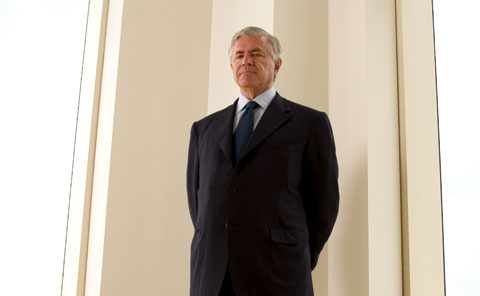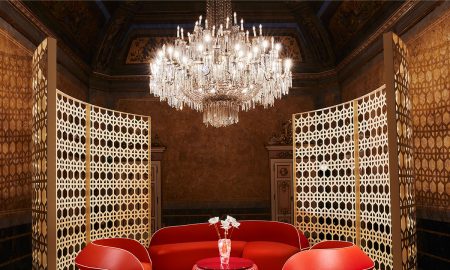It’s difficult to spend a day in Manhattan and not spot a Costas Kondylis design. With over 60 buildings to his credit in the city-and more on the way-Kondylis has left an indelible mark on the metropolis, ever since arriving on U.S. shores in the late 1960s.
By Michael Calderone
“New York was a fertile ground, because it is so open to other cultures,” he says. “I felt, from the first day, that I would be very comfortable.”
Some well-known architects crave the academic spotlight, impressing only their colleagues with conceptual sketches, but Costas Kondylis is not one of them. He wants to transform his ideas into reality. For Kondylis-who runs Costas Kondylis and Partners, an architectural firm, and Kondylis Design, an interior design firm-it’s vital to produce groundbreaking ideas that can work in the marketplace.
“What I always try to do is marry good architecture with good business,” says Kondylis, seated in his Manhattan office. “You have to propose design solutions that increase the value of the building.”
So, with an architectural vision-and sharp business acumen-it’s no surprise that Kondylis has been able to satisfy one particularly tough customer: Donald Trump. Since working on designs for Trump Plaza in the 1980s, Kondylis and Trump have completed several projects together, including the sprawling Riverside Boulevard residences, the conversion of the Delmonico Hotel into Trump Park Place, and one of the city’s tallest buildings, Trump World Tower.
“Donald is a visionary,” says Kondylis. “He has developed his own brand. To work with Donald, you have to realize that the building can look round, square, have balconies or no balconies-but it has to look like a Trump building.”
For the 860-foot-tall Trump World Tower, technological innovation was needed in developing the Miesian skyscraper that now overlooks the United Nations (and most of the city). Indeed, there are 72 floors; yet, because of ceilings that can reach as high as 16 feet, the slender building is closer to 90 stories tall. But height was not the only concern – there was also Trump’s stern guidance with regard to the interiors. He said, “Make sure this is the best apartment building in Manhattan.”
In New York City, there are famous skyscrapers that can be seen for miles, have appeared in countless films and adorned millions of postcards. For Trump World Tower, which became the world’s tallest residential building, Kondylis used a minimal design that differed greatly from the limestone, Art Deco skyscrapers of the past. “We didn’t try to mimic the Chrysler Building or the Empire State Building,” he explains. “We wanted to create something minimal, like a slab of glass.”
For the interiors, Kondylis harkened back to the pre-war apartments of architect Rosario Candela while bearing in mind the manner in which affluent New Yorkers wish to live today. And, of course, there are the far-reaching views. “One of the major amenities is the views that you get out of a building,” said Kondylis. “You dominate the most beautiful man-made landscape ever, which is the Manhattan skyline. We did floor-to-ceiling glass so you have the effect of mansions in the clouds.”
Long before Kondylis was designing “mansions in the clouds,” he received a unique education, growing up on different continents and traveling extensively. Born in the Belgian Congo, Kondylis left for boarding school in Greece at age 13. Six years later, he was living in Switzerland, and subsequently received a master’s degree in architecture from the University of Geneva. “Living in Switzerland for ten years,” he says, “I had the opportunity to travel throughout Europe.”
Eventually, Kondylis set forth for New York City in the late 1960s, where he studied urban design at Columbia University, completing a second master’s degree, and began work in the field. “New York was a fertile ground, because it is so open to other cultures,” he says. “I felt, from the first day, that I would be very comfortable.”
For the next dozen years, Kondylis received his practical education in architecture at Davis Brody & Associates. Next, he became a senior partner at Philip Birnbaum & Associates, a firm well known for its white-brick apartment buildings throughout the city. But the Manhattan real estate landscape was changing. “I joined firm in the 1980s,” says Kondylis. “That coincided with the advent of the condominium.” Over nine years at the firm, Kondylis grew immensely as an architect and took credit for his first design: a residential building called Manhattan Place. In 1989, with his own designs already being built in Manhattan and the condominium craze in full swing, Kondylis broke out on his own.
In addition to hiring many talented architects and designers over the years, Kondylis now has help from his family at the office, too. Alexia, his daughter-who holds a master’s degree in fashion design-runs Kondylis’s design studio. “My late wife was an interior designer, so Alexia grew up in an environment where we talked about design,” recalls Kondylis. “She started drawing when she was five or six years old. I could tell that she had a talent.”
Over at the Plaza Hotel, certainly one of Manhattan’s most famous buildings, Kondylis’s firm is in charge of the interior design of the current conversion that will result in a five-star hotel and luxury condominium. Because it’s such a massive undertaking, three of the firm’s architects are working daily onsite. “It’s a phenomenal project,” says Kondylis, who admits that it’s also “one of the most complicated projects we’ve ever worked on.” Obviously, all eyes are on this conversion, which is slated for completion in 2007-exactly one century after the regal doors of the original hotel first opened up.
“It’s going to be one of the greatest adapted uses of a classic hotel in Manhattan,” predicts Kondylis. “All the major public spaces have been renovated and preserved. The public’s going to get back a beautifully renovated project.” But while the public will be able to once again have a cocktail in this classic New York setting, luxury condominium buyers will reap the benefits as well. “The apartments will have traditional, classical layouts,” says Kondylis. “We’re trying to do things the way the original architects were doing them. Anything new in the building is made to be compatible with the classic.”
“Very often people ask me, what it is that I do in the firm,” says Kondylis. “I tell them that I orchestrate the whole scenario. I compare myself to the conductor of a symphony orchestra.”
Unlike the three well-lit floors that comprise his firm, Kondylis’s personal office is painted completely black, a welcome refuge from the frenetic pace he keeps up at the firm. “My favorite time is design time,” he says. “I like to spend more and more time on design. It’s the black room. It’s a relief because I am surrounded all day by white walls. It’s soothing.”
On the black bookshelf, there are a variety of works-architectural monographs, a Donald Trump biography, and a lengthy work by social theorist Walter Benjamin-that help illustrate the different sides of Costas Kondylis. There’s the seasoned architect and designer; a skilled businessperson who’s tangled with a developer that has turned firing people into a catchphrase; and the well-traveled intellectual with two graduate degrees and plenty of stamps on his passport.
Yet at work, Kondylis still wants to be seen as one member of the creative team. “I tell them to consider me one of the design players,” he says. And his favorite time is the few weeks of brainstorming during which new designs are born, what he calls “the dreaming period.” He puts it this way: “We take a couple of weeks to dream architectural concepts. Then we take these concepts and try to turn them into reality.”
Outside of Manhattan, his architectural firm is working in Connecticut, Boston, and South Beach-site of the newly designed W Hotel. And far from Manhattan, Kondylis is looking towards burgeoning cities like Qatar and Dubai, where his firm is doing two detailed master plans.
“It’s interesting because you don’t have the limitations, the restrictions, that you have in New York,” he says. “There is more freedom. It is exciting what is happening there. Being in Dubai is much more awesome than any photograph. It is a city growing in the middle of the desert. It’s almost a like a major urban experiment.”
Next year, Kondylis will be celebrating his 40th year as an architect working in New York City. To mark the occasion, there will be a retrospective of his work in a Manhattan gallery. After four decades, you might think Kondylis would simply rest on his laurels. But that doesn’t seem to be the case.
“When you do 60 to 70 buildings in Manhattan, you are creating an environment for people,” he says. “I am excited to be involved in taking design to the next level. I’d like to see the firm evolving, breaking into the 21st century. I enjoy what I do. But there’s always room for improvement.”

























